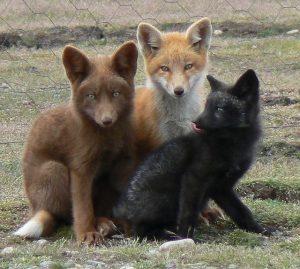
What do you have in mind when you hear the word “foxes”? Cunning little animals that would sneak into backyards, perhaps? Or the mysterious creatures with beautiful fire-like tails? Foxes are very popular in many cultures’ folklores and mainly introduced as one or both of the characters mentioned before, which is why people are familiar with those images of them. But what foxes really are like in real life and in the nature as wild animals? We will take a look at that shortly, also to get to know these 6 Siberian foxes that bear different characters – from the cutest to the angriest one.
Fox Facts
Among the 37 species of foxes that live all over the world, red fox is the most popular one. This is because red fox is the most widely spread type of foxes in the world. They exist across the entire Northern Hemisphere including the Arctic Circle. This is possible to happen because red fox is the only kind of foxes that could adapt to all kinds of environment while the other types live in very limited regions and some are even already extinct. The other popular types of foxes other than red fox are grey fox, arctic fox, fennec fox, kit fox, and swift fox.
Although foxes are parts of the canine family, they don’t live in packs. Some foxes choose to travel with their small families, and some love to be solitary. This omnivorous mammal hunts alone and would “save” extra food for later by burying it. In general, foxes are intelligent, inquisitive, and very bright. Their beautiful appearances are stunning with the bushy tails as their signature looks. The length of a fox’s tail is longer than half of the body’s length and associated with brush – because it is how it looks like. The build is also what distinguish fox from the rest of the canine family – it is smaller and sleeker.
Another thing that makes foxes unique is the sounds they make. Foxes don’t bark like dogs, instead they make 20 different sounds that work as a language for them. Some of the noises associated with foxes are “screams”, howls, whimpers, high-pitch singular noises, and cries that sound like human baby’s. These noises are among the things that make foxes labelled as mysterious creature and said to know how to transform – well, this is a myth, obviously.
The Siberian Foxes Facts
Foxes are naturally wild and they belong to the woods. But, there is one kind of this majestic creature that got purposefully domesticated. It is the Russian red fox, also known as Siberian fox. Here are some facts about them:
1. Dmitry Belyayev was the scientist who came up with the idea to try and genetically select wild foxes and turn them into domesticated animals – much like dogs. He started the experiment in the 1950s by choosing the most docile foxes from fur farms around Russia. Yes, there was such thing in Russia as farms where the animals were bred for their furs, and fox was one of them. Belyayev was the head of the Department of Fur Animal Breeding at the Central Research Laboratory of Fur Breeding in Moscow and had to let his job go because of his ambition over his experiment.
2. The selected foxes were then taken to a farm in Novosibirsk, Russia to be bred generation over generation until they finally find baby foxes that would display tameness and eager to establish contact with humans. These foxes are called domesticated elite because they passed the test that then allowed them to be released from the breeding center and taken home as pets.
3. The process of taming the wild red foxes affected the level of their adrenaline and caused the Siberian foxes to bear different colors of fur; they become mottled or spotted. Their physical appearances also change; the ears got floppier, the legs, tails and snouts got shorter, and the skulls got wider. These changes happened because their purposes have shifted from being predators to domesticated animals.
4. The foxes in the Novosibirsk breeding center are divided into three classes; Class III is for the least domesticated foxes that would run away from the experiments and bite when handled, Class II contains foxes that would let themselves be stroked and handled but show no friendly responses, while Class I is for the elites that are friendly and would wag their tails when experimenters come to handle them. Today, almost 80 percent of the total population of the foxes in the farm belongs to the Class I.
5. Even though Siberian foxes are already tamed and domesticated, they need extra care when moved into a home and taken in as parts of the family. These foxes still need to play outside and can jump as high as 6 feet tall which requires fences to be built around the yards. They also still show the instinct to bury things which should make the humans that live with them aware that ground must be provided to prevent them from digging the interior of the house.
6. Siberian foxes are legal in several regions in the world to be adopted as pets, but since the excitement over them has been high, frauds had been caught selling wild foxes while claiming them as Siberian. The only way one can safely and legally adopt a Russian red fox is through their farm in Novosibirsk and get proper information about how to do one. Not everyone is suitable to live with Siberian foxes, just like Siberian Huskies or Samoyeds.
Did the 6 facts about the Siberian foxes above surprise you? Some of us may not agree with this sort of experiment because what naturally belongs to the wilderness should stay that way. Some may think it is alright as long as the animals don’t get hurt in the process. To each their own. How about you?
